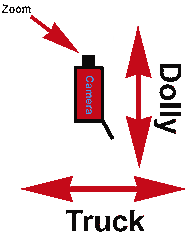Shot Descriptions
8. (WS)- wide shot, (LS) long shot, or establishing shot
9. (XLS) or (ELS)- extreme long shot
10. (LS)- long shot or FS (full shot).- With people, this is a
shot from the top of their heads to
their feet.
11. (MS)- an MS is normally a shot from the waist up.
12. (MCU) (medium closeup) is a shot cropped between the
shoulders and the belt line.
13. (CU) A relatively straight-on CU (closeup) is the most
desirable for interviews.Changing facial
expressions,
which are important to understanding
a conversation, can
easily be seen. CUs are also commonly
used for insert
shots of objects when important
details need to be
shown.
14. (XCU) or (ECU) -are extreme closeups. On people this
type of shot is reserved for dramatic
impact. The XCU
shot may show just the eyes of
an individual. With
objects an XCU is often necessary
to reveal important
detail.
15. (2-S and 3-S)- A two-shot or three-shot (also )
designates a shot of two or three
people in one scene.
16. (O/S)-over-the-shoulder shot-shows the camera looking
over the shoulder of someone nearter
to the camera.
17. (X/S) -a cross-shot looks alternately at one or the other
person, with the camera near person
totaly out of the
shot.
18. (subjective shot)- indicates that the audience (camera) will
see what the character sees. Often
it indicates a handheld
camera shot that moves in a walking
or running motion
while following a character. Subjective
camera shots can
add drama and frenzy to chase
scenes.
19. (Camera angles) - bird's eye view, high angle, eye-level,
and low angle. |
 |

 Project 1: Camera Moves and Shots
Project 1: Camera Moves and Shots
